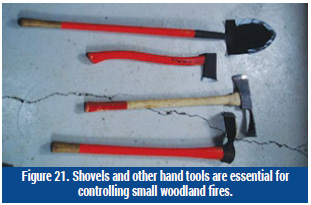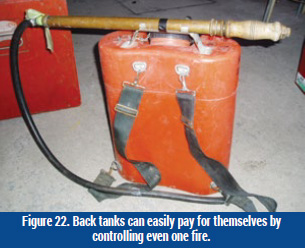Module 16: Wildfire and Your Woodland
Lesson 5 - First Strike: Tools and Equipment for Wildfire Fighting
We’ve looked at the importance of reducing the potential wildfire fuel that may be present on your woodland and access roads. Despite your best efforts, wildfire can still be a threat. While prevention measures go a long ways toward reducing the risk of wildfire, events can take place that are beyond your control. If a fie should start on your woodland, it can often be extinguished if the proper tools are at hand, and in good condition. No one wants to be facing a small blaze with a broken shovel or non-functional back tank!
The Importance of Proper Equipment
If you are carrying out work on your woodland by yourself during fie season, you should have on hand a shovel and a filled back tank, at a minimum. Mechanical equipment that may be on-site, such as a farm tractor, should have an approved and inspected fie extinguisher on board and easily accessible.
Heavy equipment working in the forest must carry fie suppression gear, and most modern harvesters and forwarders are outfitted wit onboard fie extinguishers and spark arresters. Older equipment, particularly skidders and forwarders, may not carry such devices and it is up to the owner or operator to make sure the proper fie equipment is present.
SHOVEL
A shovel can be the most useful fire suppressant tool you can have on hand. Small surface or grass fires can be beaten down with a shovel. You can also create a small fire break in the path of a fire, and soil can be quickly shoveled on a fire to smother it. A heavy-duty shovel can be used to break up large smouldering embers into smaller chunks, which can then be covered in soil. Make sure that your shovel is in good condition, and inspect the handle regularly for cracks and other damage that is often overlooked.
|
|
It is important to make sure that mineral soil is used to extinguish embers, rather than the top organic layers of the soil (commonly called duff), which may contain combustible material. You don’t wish to be adding fuel to the flame!
Back Tank
Although it will cost a few hundred dollars to purchase, a back tank can be essential in helping to control the spread of a small fie. Make sure that during fie season your back tank is filled at all times, voiding the awkward situation of having an empty tank when you may need it most!
The water from a back tank helps extinguish a fie by both smothering and cooling the flames and embers. Blasts of water from a back tank pump can effectively penetrate smouldering wood and duff. Adjustable caps on the nozzle can direct either a single jet or a shower of water. The shower often works well for drenching areas in advance of a fire.
|
|
In areas where water is not readily available for refilling our back tank, a large steel barrel or plastic tank can be used for storing water during fie season. Make sure the container is large enough to immerse the entire back tank for filling.
A back tank and shovel can be a very effective combination in controlling small woodland fies. Make sure these tools are available to anyone who is using your woodland during fie season and that they know their storage location.
Other Firefighting Tools
Although response times and effective firefighting techniques have improved over the past three decades, many tools remain much the same. Chainsaws are still used to clear fie breaks in the forest to prevent the rapid advance and crowning of wildfires. They can also be used to cut trails for the movement of firefighters and equipment.
Portable pumps, which run on gasoline engines, are used to draw water through hoses from streams, rivers, ponds, and holding tanks. The ability of pumps to quickly move water uphill makes them particularly valuable. Such pumps can cost thousands of dollars, depending on their size and complexity, and their price prevents most woodland owners and contractors from acquiring them.
Axes and grub hoes are useful in cleanup efforts once wildfies have been controlled. They can be used to cut through roots and debris to reach embers, and in scalping duff layers from the soil surface.
|
|



